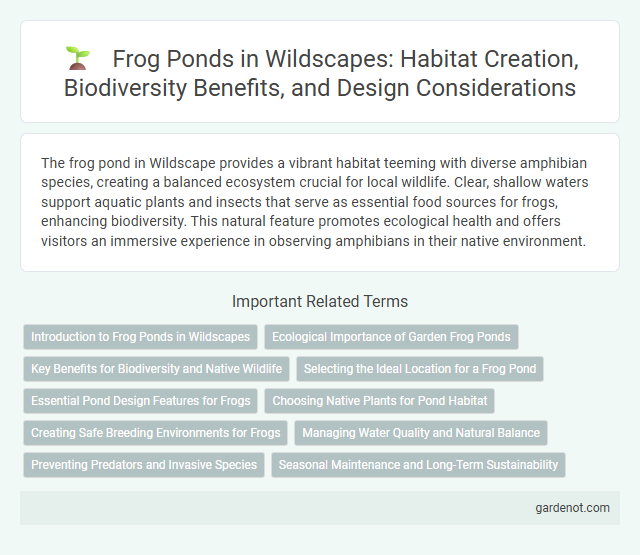The frog pond in Wildscape provides a vibrant habitat teeming with diverse amphibian species, creating a balanced ecosystem crucial for local wildlife. Clear, shallow waters support aquatic plants and insects that serve as essential food sources for frogs, enhancing biodiversity. This natural feature promotes ecological health and offers visitors an immersive experience in observing amphibians in their native environment.
Introduction to Frog Ponds in Wildscapes
Frog ponds in wildscapes serve as critical habitats supporting diverse amphibian populations and enhancing ecosystem biodiversity. These water bodies provide essential breeding grounds for frogs, contribute to natural pest control by sustaining insectivorous species, and improve wetland health. Incorporating frog ponds into wildscapes balances aquatic and terrestrial environments while promoting ecological stability and wildlife diversity.
Ecological Importance of Garden Frog Ponds
Garden frog ponds provide critical habitats for amphibians, supporting biodiversity by offering breeding grounds and shelter for various frog species. These ponds enhance local ecosystems by promoting natural pest control through amphibian populations, which feed on insects and larvae. Maintaining healthy frog ponds contributes to water filtration and nutrient cycling, essential for ecological balance in garden environments.
Key Benefits for Biodiversity and Native Wildlife
A frog pond provides essential breeding habitat for amphibians, supporting diverse frog and toad populations critical to ecosystem health. It enhances local biodiversity by attracting native wildlife such as insects, birds, and small mammals, creating a balanced food web. Natural water filtration in the pond improves water quality, benefiting surrounding flora and fauna.
Selecting the Ideal Location for a Frog Pond
Choosing the ideal location for a frog pond involves prioritizing a shaded area with partial sunlight to maintain optimal water temperature and support amphibian health. A site near natural vegetation provides shelter, food sources, and protection from predators, enhancing frog habitat quality. Ensuring the pond is away from busy areas and chemical runoff reduces stress and contamination, promoting thriving frog populations in the wildscape.
Essential Pond Design Features for Frogs
A well-designed frog pond prioritizes shallow edges with gradual slopes to facilitate easy entry and exit for frogs, mimicking their natural habitat. Incorporating aquatic plants like water lilies and submerged vegetation provides essential shelter, breeding sites, and oxygenation, ensuring a healthy ecosystem. Clean, chemical-free water with varied depths supports tadpole development while deterring predators, creating an optimal environment for frog populations to thrive.
Choosing Native Plants for Pond Habitat
Selecting native plants such as pickerelweed, cattails, and water lilies enhances frog pond habitats by providing essential shelter and breeding grounds. These plants support the pond's ecosystem by maintaining water quality and offering food resources for tadpoles and adult frogs. Incorporating a variety of native species creates a balanced environment, promoting biodiversity and serving as a natural defense against invasive plants.
Creating Safe Breeding Environments for Frogs
Creating safe breeding environments for frogs in wildscape frog ponds involves maintaining clean, pollutant-free water and providing dense aquatic vegetation for shelter and egg-laying. Incorporating shallow areas with varied depths mimics natural habitats, promoting successful tadpole development and reducing predation risk. Regular monitoring of water quality and minimizing human disturbance ensure a supportive ecosystem for frog populations to thrive.
Managing Water Quality and Natural Balance
Maintaining optimal water quality in a frog pond involves regular monitoring of pH levels, dissolved oxygen, and temperature to support amphibian health. Incorporating native aquatic plants like water lilies and cattails helps absorb excess nutrients and provide shelter, promoting a balanced ecosystem. Natural filtration methods, such as gravel substrates and biofilters, effectively reduce harmful algae and maintain clear water conditions essential for frog populations.
Preventing Predators and Invasive Species
Effective management of frog ponds in wildscapes involves installing fine mesh screens and using natural barriers to prevent entry of predators such as birds and snakes. Regular monitoring and removal of invasive species like bullfrogs and non-native fish help maintain ecological balance and protect native amphibian populations. Creating habitat complexity with native plants supports frog health and resilience against invasive threats.
Seasonal Maintenance and Long-Term Sustainability
Seasonal maintenance of the frog pond at Wildscape involves removing debris, controlling algae growth, and checking water quality to ensure a healthy habitat for amphibians. Long-term sustainability includes planting native aquatic vegetation to support biodiversity and implementing erosion control measures to preserve pond integrity. Regular monitoring of amphibian populations helps track ecosystem health and informs adaptive management strategies.
Frog pond Infographic

 gardenot.com
gardenot.com